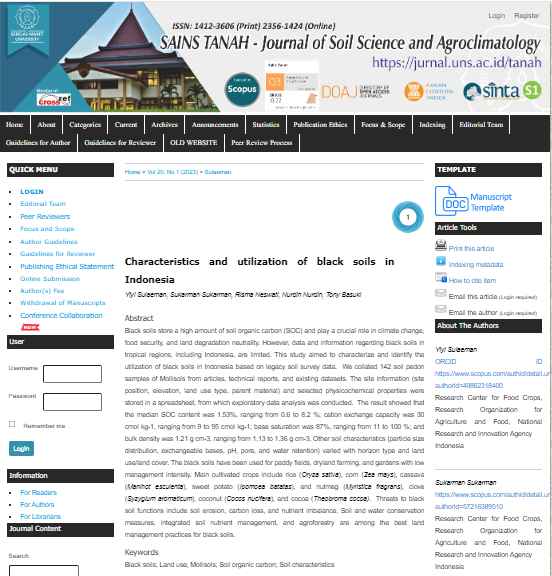Characteristics and utilization of black soils in Indonesia

SAINS TANAH - Journal of Soil Science and Agroclimatology, Vol 20, No 1 (2023)
Yiyi Sulaeman, Sukarman Sukarman, Risma Neswati, Nurdin Nurdin, Tony Basuki
Abstract
Black soils store a high amount of soil organic carbon (SOC) and play a crucial role in climate change, food security, and land degradation neutrality. However, data and information regarding black soils in tropical regions, including Indonesia, are limited. This study aimed to characterize and identify the utilization of black soils in Indonesia based on legacy soil survey data. We collated 142 soil pedon samples of Mollisols from articles, technical reports, and existing datasets. The site information (site position, elevation, land use type, parent material) and selected physicochemical properties were stored in a spreadsheet, from which exploratory data analysis was conducted. The result showed that the median SOC content was 1.53%, ranging from 0.6 to 8.2 %; cation exchange capacity was 30 cmol kg-1, ranging from 9 to 95 cmol kg-1; base saturation was 87%, ranging from 11 to 100 %; and bulk density was 1.21 g cm-3, ranging from 1.13 to 1.36 g cm-3. Other soil characteristics (particle size distribution, exchangeable bases, pH, pore, and water retention) varied with horizon type and land use/land cover. The black soils have been used for paddy fields, dryland farming, and gardens with low management intensity. Main cultivated crops include rice (Oryza sativa), corn (Zea mays), cassava (Manihot esculenta), sweet potato (Ipomoea batatas), and nutmeg (Myristica fragrans), clove (Syzygium aromaticum), coconut (Cocos nucifera), and cocoa (Theobroma cocoa). Threats to black soil functions include soil erosion, carbon loss, and nutrient imbalance. Soil and water conservation measures, integrated soil nutrient management, and agroforestry are among the best land management practices for black soils.
KeywordsBlack soils; Land use; Mollisols; Soil organic carbon; Soil characteristics
Scopus Q3 dan Sinta 1: https://doi.org/10.20961/stjssa.v20i1.70343
Kategori
- Abstract 2006
- Abstract 2009
- Abstract 2011
- Abstract 2012
- Abstract 2013
- Abstract 2014
- Abstract 2016
- Abstract 2018
- Abstract 2019
- Abstract 2020
- Abstract 2021
- Abstract 2022
- Abstract 2023
- Abstract 2024
- Abstract 2025
- Buku
- Kiprah Tugas Pembantuan ASN-Dosen
- Kunjungan Luar Negeri
- Mata Kuliah
- Pengukuhan Guru Besar, Prof. Dr. Nurdin, SP, MSi
- Project 2009
- Project 2010
- Project 2013
- Project 2018
- Project 2019
- Project 2020
- Project 2021
- Project 2022
- Publikasi Ilmiahku
- Soil Scientist from Gorontalo
Arsip
Blogroll
- a-SintaID
- b-Google Scholar
- c-Scopus ID
- d-Web of Science (WoS) ID
- e-ResearchGate
- f-Academia.edu
- g-SciProfiles
- h-Loop ID
- i-LinkedIn
- j-OrcidID
- k-figshare
- l-Youtube
- m-Twitter
- n-Facebook
- o-Universitas Negeri Gorontalo
- p-BIMA-Kemendikbud RI
- q-FAPERTA UNG
- r-LP2M UNG
- s- LP3M UNG
- t-SIMPPM UNG
- u-SIMLIT UNG
- v-Rispro LPDP
- w-BRIIN
- x-PDDIKTI
- y-GRS BPDPKS
- z-kampusmerdeka
- z1-ANJANI
- z10-SIAT UNG
- z11-Aplikasi SIAGA
- z12-SPADA Indonesia
- z13-SISTER
- z14-tesaurus.kemdikbud
- z15-UKBI
- z16-typoonline
- z17-Turnitin
- z18-Zetero
- z2-eHAKI
- z20-Himpunan Ilmu Tanah Indonesia(HITI)
- z21-BKN
- z21-Kementan RI
- z22-BPS Provinsi Gorontalo
- z23-BPS Kabupaten Boalemo
- z24-BPS Kabupaten Bone Bolango
- z25-BPS Kabupaten Gorontalo
- z26-BPS Kabupaten Gorontalo Utara
- z27-BPS Kabupaten Pohuwato
- z3-Arjuna
- z4-DIKTI
- z5-GARUDA Dikti
- z6-SIM Karier dan SDM Kemendikbud
- z7-KBBI
- z8-Kedaireka
- z9-RAMA
